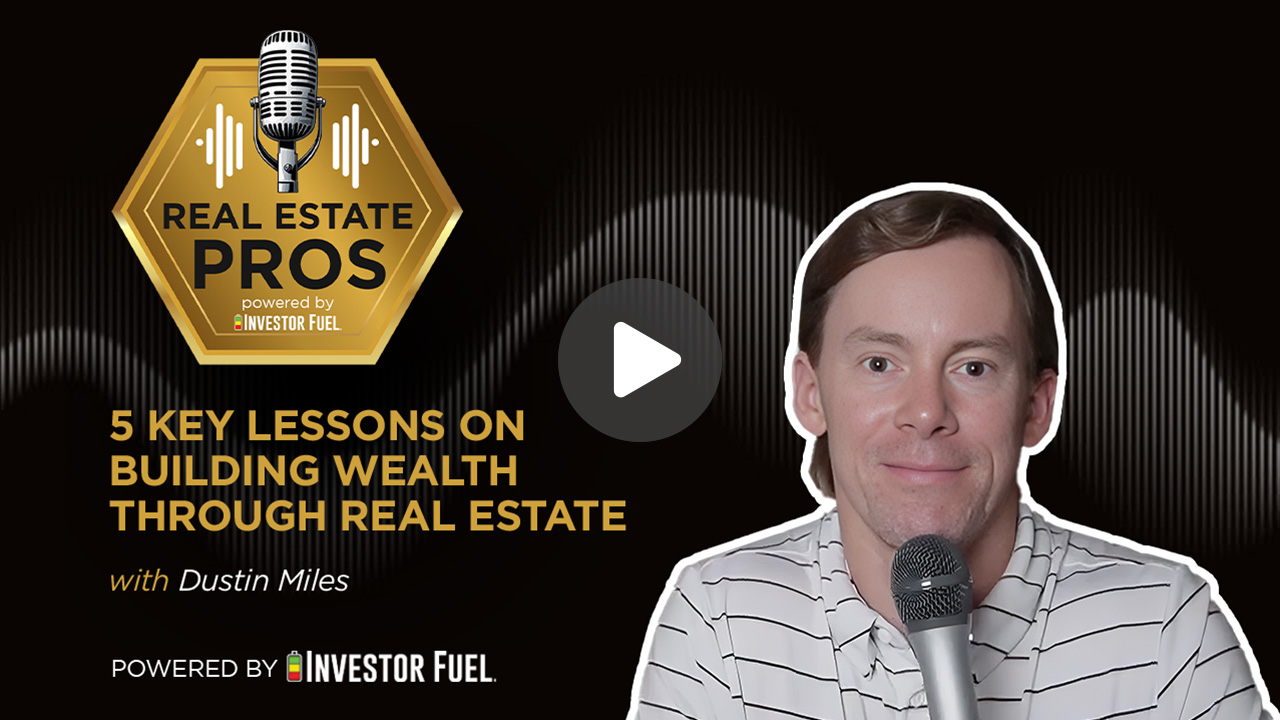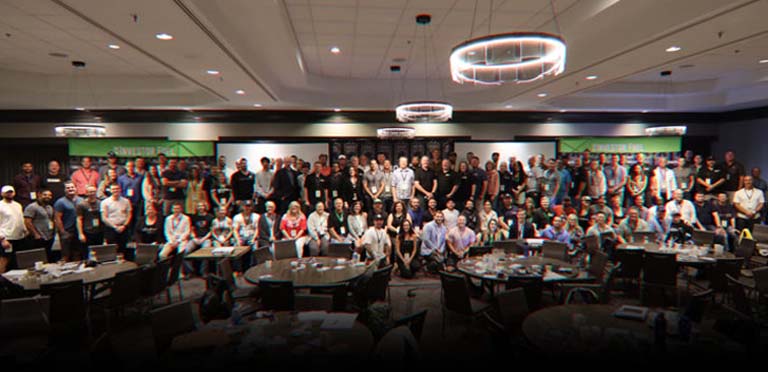
Show Summary
In this conversation, Dylan Silver interviews Dustin Miles, a real estate entrepreneur and multifamily investor from Fort Worth. Dustin shares his journey into real estate, starting from his entrepreneurial spirit as a child to his transition from single-family investments to multifamily syndications. He discusses the characteristics of multifamily properties, the evaluation process for deals, and the importance of property management. Additionally, Dustin emphasizes the significance of relationship building in capital raising and offers insights into his current business operations.
Resources and Links from this show:
Listen to the Audio Version of this Episode
Investor Fuel Show Transcript:
Dylan Silver (00:01.267)
Hey folks, welcome back to the show. I’m your host, Dylan Silver. And today on the show we have real estate entrepreneur out of Fort Worth, multifamily investor, Dustin Miles. Dustin, welcome to the show.
Dustin Miles (00:17.368)
Thanks for having me. Excited to be here. Thank you.
Dylan Silver (00:19.985)
It’s a pleasure to have you. And I’d like to start off at the top of the show by asking you how you got into the real estate space.
Dustin Miles (00:30.314)
yeah, great question. I think I’ve always been just pretty entrepreneurial in general. So, you know, as a little kid, I had, I had a candy business like eight years old. my bus driver called me the candy man. She’s kind of fun. and then I, had a e-commerce business in college and then I,
Yeah, just kind of, I went to school for engineering, got out of school and did the engineering thing for a little bit. And I was like, man, I’ve just, you know, just, you know, kind of wanted to start a business. so, um, real estate, you know, is everywhere and, and everybody needs a place to live. And so that was kind of a, a natural, um, attraction for me. And then, um, anybody who I talked to or met that, that did real estate, I was, you know, always, uh, quick to.
you know, ask them about it see how it’s going and just learn as much as I could.
Dylan Silver (01:27.325)
And so, know, that entry point into real estate for you, did you get in as a single family investor? Did you immediately do multi-family deals, which you’re doing now? What was the entry point for you?
Dustin Miles (01:40.782)
Yeah, yeah, so I started Started kind of 2006 or 2005 something like that. I Started going to you know conferences where it was, know You run to the back of the room to buy CDs and and all that And so I don’t know. I always kind of a lot of that gave me pause
Um, and so anyway, started going to local meetups, um, when I moved back to DFW. So went to, uh, all the different meetups around town. Um, probably, you know, was probably more educated than, you know, than I didn’t have any practical knowledge, but, uh, probably analyzed everything to death. And then, you know, it was probably on me. didn’t pull the trigger for awhile, but, um, I, I, we did.
Uh, mentoring with a few different groups and then had some success, uh, with lifestyles unlimited. Um, and, so anyways, did, you know, about half a dozen rentals and flips, uh, kind of started buying them in 2009, 2010. Uh, you know, I didn’t know at the time, but it was really good timing. And, um, yeah. So just started buying those, um, you know, by a foreclosure for 90,000 bucks.
it wasn’t like a super heavy lift, but I, you know, rented that out and then, yeah, did, did five others after that and had, you know, I’d say, you know, decent success. I didn’t like, it wasn’t grand slam. but it’s probably, you know, all singles and doubles. So yeah.
Dylan Silver (03:20.563)
You mentioned foreclosure. Was that deal, or those deals, did you get them at the auction?
Dustin Miles (03:25.888)
No, I didn’t. were just on on the MLS and yeah, they were yeah bought bought those So yeah, nothing I
Dylan Silver (03:35.487)
Those are typically, from my understanding, bank owned properties. I could be wrong on this, but I think they’re bank owned. Can you get a mortgage on those? Or do have to pay cash for those? How does that work?
Dustin Miles (03:45.23)
Yeah. Yeah. Um, at least at the time, yeah, I went and got, um, just a regular, uh, actually the first one was put through a smaller bank. And, um, so yeah, bought, you know, bought the deal through them. It was like a five year note. And so I’d have to renew or whatever every five years with them. I think some of the others that rentals were, and they were foreclosures. did get like a typical.
I think maybe it was like a two-step program. was because there was a good bit of rehab. So I did rehab and then I went into, you know, a typical Fannie Mae loan after that. So.
Dylan Silver (04:25.673)
So you do the foreclosures to start out and are you, any specific way that you’re underwriting these deals? What was your process like? I mean all the money’s made on the buy, right? So if we get granular here, how are you determining what to offer on these deals?
Dustin Miles (04:42.878)
yeah. So I mean, I would, I would, you know, see, you know, obviously kind of what they’re offering, but I would look at, the value. I’d get some comps. think I had access to some comp software. can’t remember. and then just kind of back, you know, back end numbers, you know, from there. And then I’d look at, because I was renting mainly. so I’d look at, you know, look at the rents and make sure that, you know, there was some, buffer there as well.
Because you know as you know not everything goes the way you planned out to be and so anyways Yeah, just try to leave plenty of buffer in there and and so that’s how you know I’m not not a single-family expert by any means, but that’s you know, basically what I did
Dylan Silver (05:17.343)
Yes, Ryan.
Dylan Silver (05:29.277)
And so you’re doing these deals by yourself or with partners, initially.
Dustin Miles (05:34.19)
Just yeah, just me and then you know did some with hard money and all that too
Dylan Silver (05:40.157)
And so at what point did multifamily start to transition from single to multi?
Dustin Miles (05:47.468)
Yeah. good question. So I, I was interested in multifamily kind of the whole time, like, cause lifestyles did single family and multifamily. so I was, you know, doing single family. I’m okay. Let me just kind of, I saw it as let me dip my toes in the water and then I’ll do multifamily after that. And, so I guess that was kind of a, you know, mind.
block or whatever that I had to do single family first before I had to do multifamily, which I have known plenty of people just to make that jump. anyways, but for me, I wanted to, you know, kind of dip my toes in the water, make sure, you know, it was okay. But I got into my first multifamily deal as a passive in 2012.
Dylan Silver (06:39.357)
And so from there, did you say, I’m going to pivot my business completely to this or was it a different trajectory that you took to really dive in a multifamily?
Dustin Miles (06:51.726)
Yeah. Um, I, yeah, I was ready. So I was doing, I don’t know the, I mean, I worked as an engineer at the time full time and I was doing this on the side. And so it was, you know, and, know, had a, uh, young family and all that stuff. So, um, you know, the, some of the rehab stuff was a little bit, a little bit of pain and then, you know, just, I had to babysit people.
and hire and fire people pretty consistently. And so, I was like, okay, I’m ready to kind of move on to, not that there’s not bumps in the road in other businesses. It doesn’t matter what business you own. If you’re anywhere near the operations, there’s going to be bumps in the road. But yeah, so 2012 really started.
Dylan Silver (07:41.907)
This is it.
Dustin Miles (07:48.278)
You know, shifting, you know, was clean, selling, you know, the single family I did have around that time. which is, guess, pretty decent timing too. And, so anyway, started to transition 2012, 2013. And then I think I was out of everything except for the first deal that I bought because it was easy rental. but yeah, and then I did my first syndication where I was the lead and put it all together in 2014.
Dylan Silver (08:18.687)
And so at that point in time, and I guess I should get some more background, today you’re not involved in engineering, it really stays your full-time thing, or are you still involved with engineering?
Dustin Miles (08:28.846)
Yeah, no, I went part-time engineer, which I just worked two days a week starting 2018. And then I left that job in 2021.
Dylan Silver (08:43.005)
And so for the last four years, you’ve been full time with it. Has the last four years been multifamily or has there been a couple of the other strategies that you’ve employed during the last couple of years?
Dustin Miles (08:47.534)
Mm-hmm.
Dustin Miles (08:54.454)
Yeah, all multifamily as far as where I’m active in all that. I do invest passively in some other stuff, businesses and oil and gas and stuff like that and Bitcoin mining. But yeah, my day-to-day business is all multifamily.
Dylan Silver (09:16.935)
And so let’s dive in, let’s get a little granular on multifamily. So when you’re looking for multifamily deals, these need to come in all different varieties. You get distressed, you get with tenants, you get no tenants. I believe multifamily is units over four. Is that correct? Anything over four would be considered multifamily. But is there a cap at multifamily? Does it like, well, once you hit this many doors, now it’s commercial or something? What is multifamily?
in general if we’re going to describe the space.
Dustin Miles (09:47.726)
Uh, yeah. Well, mean, could anything over four doors or I guess technically two or more is, is multi, but, um, yeah, once it gets commercial, it’s over four or so five and more, um, is, is considered commercial. Um, yeah. And the, the scale that we’re kind of on is we syndicate. So I don’t just have, you know, a bucket of money over there or anything.
Um, but, uh, so we, we pull funds together and so we’re buying typically, um, our deals now are, you know, are 200 units and more. Um, and you know, it, if I rewind, you know, 10, 15 years ago, there’s, you know, I’m shaking in my boots and, um, and just, yeah, there’s no way I could do that. But, um, but yeah, that’s kinda, you know, the first deal I did.
that I syndicated was 109 doors. I raised 1.6, 5, 5 million, bought the deal. It’s over in Halton city, near, near Fort Worth. And, yeah, so it’s, it was, you know, ended up, bought, you know, the timing, you know, helped a lot in, in just, you know, the return and all that good stuff. But, yeah.
Dylan Silver (11:06.015)
What would you say when you’re looking at these deals, I mean, you’re looking at so many doors here, what are the characteristics that give you insight that this might be a good deal for us to look at? it strictly, you know, what are the rents and then what are we paying for it? Or is it more in depth than that?
Dustin Miles (11:24.63)
Yeah. I mean, you know, it’s when I first got into multifamily, it’s like I was in preschool or something or kindergarten. and I think to get into multifamily right now, like if you’re wanting to be an operator and all that, you kind of need like a master’s degree. I think there’s been a huge, maturation process over the past decade or so.
Um, but, but yeah, in general, um, you know, we’re looking at the going in Capray, the location is, is, you know, huge. Um, you know, it’s the old adage of location, location, location. Um, you know, we’re looking at the condition of the asset. We’re looking at the, you know, the financials, the, the prior performance. Um, we’re looking at the comps as you, you know, had pointed out, we want, we don’t want something that’s leading.
leading the market rents. we want something that’s trailing and then kind of our business plan in general is to move it from the bottom to the middle. We don’t want to lead. want, we like buffer. So.
Dylan Silver (12:33.287)
Now, when you’re looking at these multifamily deals, are you taking on deals also that may require significant remodel, rehab, or are you looking for things that are more turnkey?
Dustin Miles (12:49.454)
Well, um, you know, I think the, if, if, if I mentioned our rehab budget, you’re going to be like, Oh my gosh, that’s, you know, you’re doing a ton of work. Um, but the, lot of the, so we have a portfolio in Houston, about 1600 units. Um, and the, deals are, most of them are 2000 newer. So they, they’re, you know, if you look at them, they’re pretty.
Um, but we’re generally spending, you know, 10,000 adores. We’re usually spending, you know, 2 million, you 2 to 3 million, 2 to 4 million, something like that. Um, on, on each project. So typically we’re doing, so it’s kind of a, I’d say it’s a lighter value add. Um, usually the.
By the time we get the offices and club houses are dated, a lot of the gym stuff is dated. A lot of the just amenities are dated. So we freshen all that stuff up. And then, for us, it’s big to kind of leave. We want to leave meat on the bone because we want someone else to be excited about, you know, all these improvements that they could do too. So we try to try to, you know, depends on the interiors that they’re already app. We try to, you know, leave a lot of room on.
a lot of meat on the bone there. So for instance, if we can be able to bump rinse and all that and just do quartz or granite or just do black appliances or sometimes stainless, we’ll try to come up with a package that works. But in general, we like to not just.
Renovate the whole complex because we want the next guy to be you be able to renovate you get a better cap rate whenever you do that. So
Dylan Silver (14:35.491)
And then how heavy is your involvement as far as, you know, overseeing the actual success of these properties, you use property managers. And if so, I’m curious, you know, what is it? What does it look like when you have these investments out and you’re using property managers? When do problems if ever come to you? And what does that look like?
Dustin Miles (15:00.008)
yeah. I mean, just to be real transparent, there’s, there’s always, I mean, you know, sometimes things are moving along pretty smoothly, but there’s look, we have, you know, we have probably 3000 residents, total. And so there’s always something going on. that’s just the, you the nature of things, but, I would say, so we, we do work with a third party management company.
Um, but we’re heavily, heavily involved. Um, so, you know, part of, you know, what we do is someone, you know, we meet with the managers every week, uh, through teams. Um, and then someone from our, our team is, is at the, at the property on a weekly basis. It’s one thing to have a zoom or teams call and it’s another to actually step foot on property and be like, okay, cool. Did they actually do what they said they were going to do?
Um, so we’re, heavily, um, involved, um, for me, um, I, you know, do, uh, quite a bit of the asset management. I’m on all the calls. Um, and then, uh, I do, you know, we have to, you know, these are big deals. We, you know, we have to raise a lot of capital. So, um, I talked to a lot of lot of capital, you know, folks kind of day in day out.
Dylan Silver (16:20.371)
Let’s talk about raising capital. It’s funny you mentioned raising capital because I had a guest on earlier today where we dived heavily, dove heavily into capital raising. What has been your strategy when it comes to capital raising? How did you learn to raise capital? Yeah.
Dustin Miles (16:27.627)
cool.
Dustin Miles (16:43.066)
Um, yeah, I think really, um, you know, I mean, I’m, I’m not so like my background’s engineering, but like, I’m not, you know, I’m not the, you know, I’m not the life part of the guy. You know, I’m not out there, you know, talking to everybody, but, um, but I’m, you know, uh, I’m, you know, pretty social in general.
And so, I think really it’s about relationships. It’s not about, you know, it’s not about focusing on money per se. It’s about building relationships. And, you know, as you have probably heard a million times, know, people do business with people that they know, like, and trust. And so it’s really just about relationship building. It’s about, you know, know, touch points. It’s about, you know, we have a podcast where I, you know,
Similar to this, where I’m building a relationship with, people that we might do business with. And if we don’t, that’s great. But like, if we do, that’s, you know, that’s awesome. So, um, so really it’s about building relationships and then it’s, um, you know, doing what you say you’re going to do and follow up is, is big as well. Um, but we, we’ve gotten a lot more, I guess, sophisticated with.
you know, our CRMs and all that stuff. And so there’s a lot of reminders for me to like reach out or for some from on someone from our team to reach out as well. Um, so I think just, you know, just trying to provide value, being, you know, Austin transparent and, um, and just, you know, I think a lot of people, uh, yeah, that goes a long way with a lot of people and you know, you’re, know, as long as you’re not too, um, you know,
there’s too much friction or, you know, as long as you’re a nice person, you know, you can probably do pretty well in the capital raising space.
Dylan Silver (18:38.035)
I tend to agree. I’ve had other conversations with folks who’ve said, know, well, it’s not as easy as going out and just saying what you’re doing to a bunch of people. I tend to think actually that’s the starting block is you have something that is specifically real estate, right? There’s take some level of knowledge and expertise, some core foundational skills to be able to do. People on the outside may have money, but they may not have the time or the understanding. And so if you tell everybody, hey, this is what I’m doing.
Dustin Miles (19:00.174)
Mm-hmm.
Dylan Silver (19:06.979)
in real estate, and then this is how much capital I’m raising for this. If they know like and trust you and they have no other, most people have no other vehicle to invest in real estate, they may take a shot on you. And then you know, you get one person that adds credibility, which is another factor, right? So now you have maybe their network that you can tap into from there. And then before you know it, people are coming to you. And so I’ve experienced this recently, even shockingly so, where I was like, Whoa, I didn’t think that
Dustin Miles (19:29.474)
Yep. Yep.
Dustin Miles (19:34.402)
Wow.
Dylan Silver (19:36.115)
This is going to work and it did. And to a point where I was like, well, now I’ve actually got more capital than I thought I had ever even remotely planned for. What do I do now? And this is crazy because if you just took the same me a month ago, a little bit more than that, 45 days ago, I would have said that that’s totally impossible. But just I’m talking to a couple of people telling me, you know, you can either bootstrap, you know, you can
like be an asset manager or you can raise capital from other people and put it injected in your business. You know, these are a handful of ways to make money and you know, you don’t have to stick to one. That was huge for me. But Dustin, we are coming up on time here. Where can folks go to maybe learn more about your business or to reach out to you?
Dustin Miles (20:29.26)
Yeah. I’m, I’m, trying to do better about, you know, about posting on LinkedIn. So you can find me on LinkedIn Dustin W miles. And, and then, yeah, you’re welcome to shoot me an email. email is just Dustin at momentum multifamily.com. And if you just want to learn more about us, go to momentum multifamily.com and, would love to love to chat.
I’d love to just help you in a way we can.
Dylan Silver (21:01.503)
Congrats on all your success and to your continued success.
Dustin Miles (21:08.654)
Thank you. Yeah, I appreciate it. Thanks for having me.







